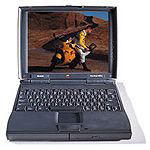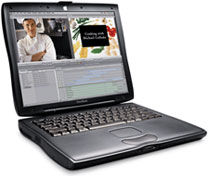I have mixed feelings about trying to use really ancient Macs for
production work.
If all you need is a typing platform, sure. Just about any Mac ever
made running software from its era will do, but with the Internet and
the Cloud looming ever larger, while there may be workarounds possible,
is it really worth the trouble with more powerful machines so
abundantly available at affordable prices?

PowerBook 1400c
I have an old 117 MHz PowerBook
1400c that I used to use as my utility Mac when a 700 MHz iBook was my main
production machine. It has a nice keyboard and is reasonably lively
running Mac OS 8.1 (a complete dog
running OS 9), but even
5-6 years ago it was borderline due to sluggish Internet performance
using browsers - and the lack of WiFi support would completely rule it
out for me today.

Pismo PowerBook G3
On the other hand, it depends to some degree on how you define
"really ancient". I have two 11-year-old Pismo PowerBooks in active
daily service. They're somewhat hot-rodded, with 550 MHz G4 processors,
RAM maxed-out to 1 GB, 8x DVD burner SuperDrives, and both have
internal AirPort cards, which are excellent. I also have a FireWire 800
PC Card adapter. I've never gotten around to picking up a USB 2
adapter, but three of my five external hard drives support FireWire, so
I've never really felt any compelling need.
However, the two most important enablers these days are software,
not hardware, namely the wonderful TenFourFox port of
Firefox 8 to PowerPC, and the fact that
Dropbox
supports OS X 10.4 Tiger. I expect that I'm
living on borrowed time with both. Eventually, Firefox's Gecko browser
engine code will advance beyond tweaking for PowerPC support, and
presumably, Dropbox will eventually drop Tiger support as well, at
which point it will be curtains for the old Pismos in practical
terms.
Why Are You Doing This?
But it also depends somewhat, I suppose, on the basic purpose of the
exercise. If it's the challenge of getting some useful service from a
superannuated Mac, then the pure practicality of the project will be a
secondary issue. For me, it's about the appropriate tool for the
job.
As it happens, my Pismos are still well-suited to the sort of work I
do with them, without much compromise to work around. I have become
more conscious lately of their speed deficit compared with my
not-exactly-cutting-edge 2.0 GHz Late 2008 Aluminum Unibody
MacBook, but usually only when executing a big AppleScript or doing
graphics work, and even then it's still reasonably tolerable. Mostly
I'm typing, marking up and editing text, or doing research on the Web,
and the Pismo is plenty fast enough for that, plus it has a superbly
comfortable keyboard, which remains one of its major attractions as a
work platform. I like the Pismo keyboard better than the one in the
1400c.
Economic Issues
That said, notwithstanding my consummate enthusiasm for the Pismo, I
agree with Low End Mac colleague Dan Bashur, who says he's always
wanted to max his Pismo out for fun, but the cost of upgrade bits
doesn't make it a very cost effective proposition if you're starting
out with a box-stock machine. Dan costed out a full-course Pismo
hotrodding upgrade project and came to a grand total of roughly $1,100
for parts, a sum for which you can find a brand new 13" Core i5 MacBook
Pro at some resellers.
As much as I love my souped-up Pismos, most of the breathing-on was
done back when the machines had a higher intrinsic value, and given the
choice between the ultimate Pismo hot rod and a new MacBook Pro, I
wouldn't have take long choosing which one to go with - and it wouldn't
be PowerBook.
What About Tablets?
Continuing with money matters, if what you're after is simply an
inexpensive computer for light to moderate duty service, these days
there's also the tablet option. For what it's worth, I happen to find
myself typing this screed on my iPad, which, with the great little text
processor app
TextKraft, is turning out to be a decent composition platform
despite my misgivings. Not nearly as good as a laptop, unless you
happen to want to work comfortably situated on the living room sofa,
which is where I happen to be right now, or some other location that
doesn't lend itself to practical laptop body-English. Even the virtual
keyboard is not so bad when used with TextKraft's several keyboard
functionality enhancements.
The iPad is good enough that l'm thinking of postponing my next
workhorse system upgrade, which would normally be coming in early 2012.
I'm not 100 percent decided on what I'll be doing about that yet. If I
was more enchanted with OS X
10.7 Lion, it might be harder to hold off, but If I'm going to be
cumbered with a tablet user interface, I might as well just stick with
the tablet.
About Lion...
Okay, slightly bitter exaggeration there, but the UI changes in
Lion, not to mention the arbitrary termination of Rosetta support for
PowerPC legacy applications, don't entice me in the slightest.
However, I'm already beginning to encounter the odd third-party app
that demands OS X 10.7, and the time is likely not far off when I'll
need a Lion-capable Mac to maintain software compatibility and
professional relevance. Yes, I know my MacBook can run Lion, but my
hard drive is getting filled up, I don't have room on my number two
partition for a proper parallel Lion installation, and I'm not inclined
to mess with my sweet-running Snow Leopard install on this machine.
So maybe I the new year, I'll make a move, but I think I'll wait and
see what the next generation Ivy Bridge powered machines bring. There's
also the conundrum of whether to go with a MacBook Air or take a more
practical tack and get a 13" MacBook Pro. Emotion vs. reason.
But all that is the opposite of getting more work out of an elderly
Mac, isn't it?




